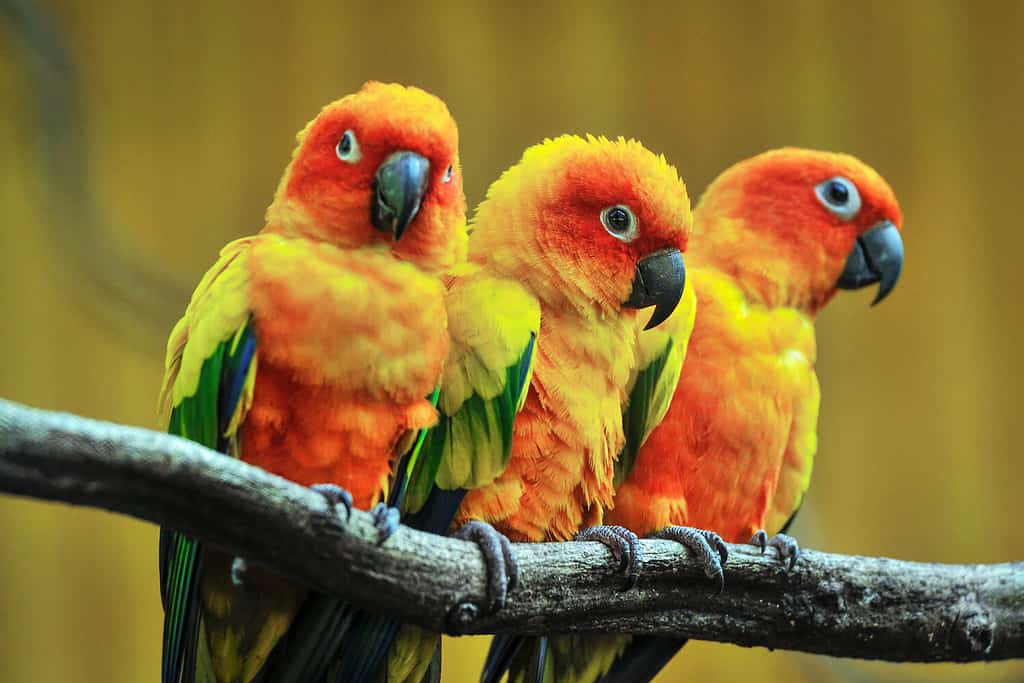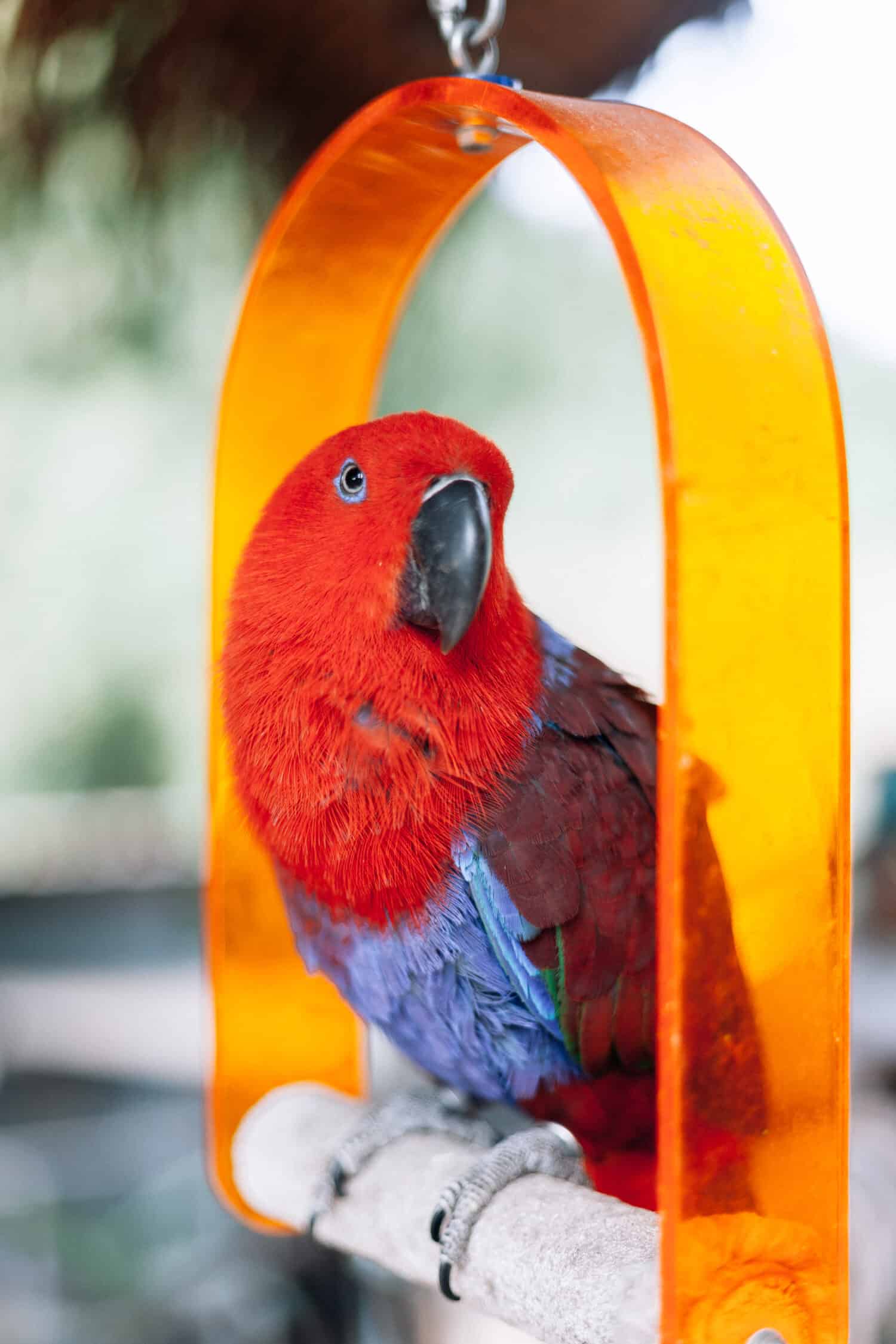The brightly colored sun conure is a native of northeastern South America. Sun Conures are sometimes known as sun parakeets. Because of their widespread appeal among bird lovers, you’ll come across them more often in people’s homes than in their native environment.
They have developed into a favorite pet over the last few years among people who enjoy keeping vibrantly colored wildlife. The sun conure is a stunning array of hues in various tones. Today we’re going to be discussing the stunning colors these birds have and which of these is among the rarest!
Most Common Coloring

Sun conures are between $400 and $600.
©Yatra4289/Shutterstock.com
The sun conure is a stunning array of hues in various tones. In contrast to a mature sun conure, the juvenile sun conure is mostly green in color, more precisely, its plumage is emerald.
Following his early years, the green color turns into red, yellow, and orange. The head, nape, chest area, and mantle are dominated by a vivid hue of yellow. Their ears become bright red, and the cheeks and belly have a delicate reddish-orange hue.
The color pattern on their wings has every hue imaginable. The vast majority of main coverts have dark blue, the smaller wing-coverts comprising vivid yellow, and the more prominent wing coverts base is green.
This bird’s tail has a dark green base and a blue tip. The conure’s legs and eye-ring are typically grey, but when it is kept in confinement the ring around the eye turns white like a Macaw. Both sexes generally have the same facial features and little variation in color marks.
Rarest Coloring
When it comes to less common color patterns on these birds, it all boils down to mutations. A sun conure’s color abnormalities were unavoidable because they have so many different colors in their genome.
Breeders constantly strive to enhance the allure of already stunning creatures through deliberate breeding. Let’s take a look at some of the rare sun conure birds that are equally as beautiful.
Pied Sun Conure

Sun conures can live up to 30 years.
©iStock.com/Thirawatana Phaisalratana
First, the pied sun conure has a different appearance from a typical sun conure. The pied mutation’s predominant hue is yellow, as opposed to the typical sun conure’s mix of many colors.
In contrast to the typical pied sun conure, which is predominantly green as a newborn, a baby pied sun conure has an exceptionally vivid yellow hue. The red pigment is absent. On their body, they will have a few tiny blue or green specks scattered about, if any at all.
In addition to being bright yellow, the plumage could also have a bit of white on its tips. Their beak will start out white, but over a period of time, it will become black. In the standard sun conure, his feet will likewise be black with white accents.
Red Factor Sun Conure

The blue and red plumage of this bird makes it easy to identify.
©panupong thiyawong/Shutterstock.com
Even though it is a rare color variation, the sun conure is nonetheless stunning and intriguing. At the beginning of the 1990s, it was initially noticed in Hawaii. From that time on, it has drawn the interest of American breeders, who have gathered these small parrots for in-house breeding or to sell to fans of this variation.
A red factor sun conure has dominant lineage, which implies that for the gene to be present and result in a red-colored offspring, one of the parents must be clearly red. A sun conure cannot give birth to a red factor baby if it is simply red in color naturally but fails to explicitly possess the red factor genes.
It may be easily identified from a typical yellow sun conure newborn because of the green tint that covers every inch of its body. Unlike a typical infant sun conure, a red factor is unlikely to produce orangish spots. Following their first molt, which occurs at roughly three months of age, the color will darken and get more vibrant.
Birds Confused For Sun Conures

The Jenday conure is related to the Carolina
parakeet
.
©Ron Paul/Shutterstock.com
Due to the conures’ same coloration, sun conures are frequently mistaken for other conures. If adequate information on other comparable conure species is absent, it is simple to be misled by a bird with a similar coloration at first glance.
To begin with, the sun conure and the Jenday conure are both the same size and shape. The vivid orange and yellow head of a mature Jenday conure resembles that of a sun conure a great deal.
The vibrant hue of this bird’s feathers is one of the Jenday conure’s distinguishing characteristics. As opposed to the sun conure, each of the wing coverts is green in color and does not exhibit any yellow coloring.
The colors of the sun conure and sulphur-breasted conure are strikingly similar. By comparing their mantles, a sulphur-breasted conure’s mantle has an abundance of green flecks whereas a sun conure’s mantle is predominantly yellow, it is easy to tell them apart.
The photo featured at the top of this post is © Srimanta Khadanga niku, CC BY-SA 4.0
Thank you for reading! Have some feedback for us? Contact the AZ Animals editorial team.







